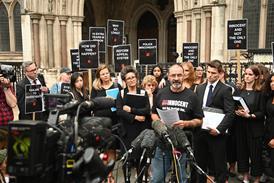A senior judge has shed light on the push by the government to conduct court proceedings via video despite widespread concerns.
Mr Justice William Davis, judicial lead on youth justice in England and Wales, told practitioners at a Youth Justice Legal Centre summit in London today that ‘as part of the so-called reform programme there’s been a huge pressure on courts to use video-links’.
However, he was aware of concerns in the youth justice community that ‘it is not a good idea to deal with children and young people who are in custody over video-link’, including sentencing them over video-link.
After raising concerns with the lord chief justice and the senior presiding judge, a practice direction that allowed the use of video-links in a wide range of circumstances was ‘rewritten in terms of young people to be much more circumscribed’, Davis said.
‘If I and the lord chief justice had not taken the steps we had, then the reform programme would have meant youths being dealt with by video-link on a much more regular basis,’ he added.
Last year the government and judiciary unveiled a £1bn programme building upon Sir Brian Leveson’s review of efficiency in criminal proceedings, which called for the introduction of ‘virtual hearings’ by email and video ‘on a more organised basis’.
In March, giving evidence to MPs, Penelope Gibbs, director of charity Transform Justice, recalled a case where the video-link worked but ‘the camera angle on the defendant was towards the top of his head, he was quite distant from the camera [and] people had real difficulties understanding what he said’.
Richard Miller, head of justice at the Law Society, told MPs there was a ‘clear difference’ between initial hearings in criminal cases where, for example, bail is being decided, and subsequent administrative hearings.
Miller said: ‘The real concern is around the initial hearings where there is a whole range of interactions that lead to the decision, for example, whether bail should be granted. The lawyer has to talk to their client, they have to talk to the prosecution, they might have to talk to the defendant’s family, there may be ongoing discussions while the case is actually being heard with the magistrates coming up with ideas for bail conditions that the lawyer then needs to take instructions on.
‘All of these interactions are very difficult to have when you are holding a virtual hearing, and the lawyer and the client are not in the same place. This is based on feedback from our members who are involved in the existing pilot projects. There are real risks, particularly when the client is vulnerable - it is very difficult indeed to build up that necessary relationship of trust between the defendant and the lawyer to ensure that the right outcome is reached.’
Video-links in family courts were branded ‘a disgrace’ by the president of the family division, Sir James Munby.


























4 Readers' comments